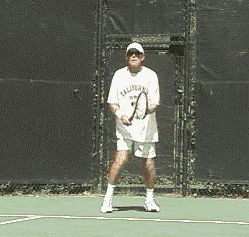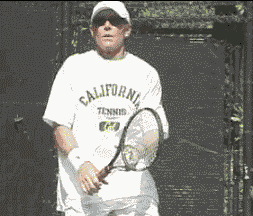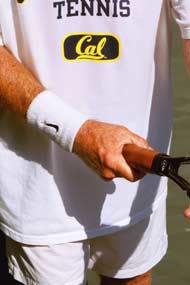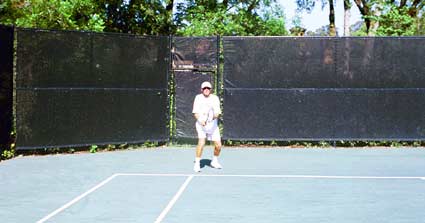
Return of Serve, part 1
by Scott Murphy

Do your returns put you in the driver’s seat?
|
The return of serve is
universally regarded as one of the most critical shots in tennis. Yet for
most players it’s also the least practiced shot--or worse never
practiced at all! At the pro level, not working on the return is unthinkable. The same should be true at any level of competitive tennis. Taking the
return for granted will limit your ability to win matches and become a
stronger player.
Let’s face it, at some point you have to break your opponent’s serve to
win a match. Occasionally there are times when getting it back will be
enough, but by and large, just putting the ball in play for the sake of
starting the point won’t put you in the driver’s seat.
A number of years ago,
I played a first round tournament match that proved to be a defining
moment in my understanding of the role of the return. It was after this
match I began to work on my return with a vengeance and—as I’ll
relate in Part 2--the time spent was well worth it.
Here’s what happened
and see if it doesn’t sound like a familiar scenario. I won the first set
easily as I was serving well and my opponent made a lot of unforced
errors. He got steadier in the second set and we battled to 5-6, with him
serving to stay in the match. In that game I had eight match points, and
“poofy” second serves to my backhand on all of them. Well, I lost that set
and the match, 7-5 in the third. A friend who was charting the match
informed me I’d had 36 unconverted break points over three sets.

The right return mentality? “I’m the Boss!”
|
Instead of playing to
win I played not to lose. I was just getting the return back in the hope
he’d make an error but, in fact, this bolstered his confidence by showing
I wasn’t capable of going after that weak second serve. When it really
mattered, I had become reactive instead of proactive, and all great returners have a proactive mindset.
Whether the server is
hitting rockets or “granny taps” you have to maintain an “I’m the boss”
mentality. Acquiring that mentality involves the physical, tactical and
positional requirements that follow.
In this article, I’m going to discuss
“the givens” or all the things a solid returner should do before he
even swings. In Part 2, we’ll look at the actual swings, stroke by
stroke.
Grips
Regardless of the grip you use, keep your hands(s) loose on the handle.
When you need to change your grip, a “death grip” will inhibit the
process, and even if you have no intention of changing your grip the loose
hands will assist in staying relaxed.
  
One-handers generally
have 3 grip options in the ready position: forehand (left), continental
(center), or
eastern backhand (right).
|
What grip should you
wait with? This is very much a matter of individual preference. For
example, at a recent men’s college match with my alma matter Cal facing
UCLA, I observed the starting grip positions of twelve players. There
were a lot of options.
The one-handed backhanders waited with a continental, or an eastern backhand grip, or
they waited with a semi-western forehand grip. Players would change
from the forehand to the backhand or vice versa, but also at times to a
continental on either side, depending on the serve and the kind of return
they decided to make.
 |
 |
Most two-handers
wait with forehand grips (left) with both hands, but some use a continental
(right) with
the right hand.
|
Most of the two-handed
backhanders waited with a combination of the grips they used on their
normal groundstrokes, that is, strong eastern to semi-western for both
hands. One two hander also used a semi-western on the backhand side (left
hand) and a continental on the forehand side (right hand). He usually
switched to semi-western on the forehand return, but the continental left
the door open for a chip off either side.
In general there were
far fewer decisions and shifts for the two-handers. Not needing to change
grips can be very advantageous for an offensive minded two-handed backhand returner.
Work at acquiring a
starting grip you’re comfortable with, and one you can stick with. Your
starting grip should allow you to change grips with ease because these
changes consume time and time is precious on the return.
The only exception to using your regular starting grip is when you feel
certain where the server is going—some players are absolutely predictable
in certain situations. In this case you can cheat over to the grip
for the return you are expecting.

The classic netural return position, with the returner equi-distant from the two
widest points the server can reach, wide and down the middle.
|
Positions
Where should you stand? The strength of the server and your strengths and
weaknesses will play a large role in this, again there are no absolutes.
As a rule, if you’re up against an experienced server, you’re better off
starting by bisecting his two widest angles, even if you’re decidedly
weaker on one side. A strong server can take advantage of an obvious
opening in your positioning.
For this reason, if you want to shift your position, do this once he’s
focused on his toss—for example moving to your left to give yourself a
better chance of hitting a forehand.
Exceptions to this
neutral starting position can be instrumental in getting into the head of
the server.

Standing to
the side can bait the server into serving to your strength
|
The server likes to think he’s the boss because, ostensibly,
you play no part in how he produces his serve. But a smart returner will
play cat and mouse to try to undermine this belief.
If a server is having
his way with you it can be invaluable to show him different looks.
Sometimes by standing further to one side you can bait the server into
going to your strength, or trying to serve to a much smaller target as he
figures you’re going to move to cover the opening.
Some servers will be
rattled if you pose a threat and stand way in. If you stay there, of
course, you’ll be half volleying your return. But you can also back up
from this position, prior to the return, once he diverts his attention to
his toss.

Playing cat and mouse with your position can get into the server’s
head.
|
The point is he’s seen you up there and he’s thinking about it. Some
servers will rise to the challenge while others will fall apart. It can be
well worth the loss of a point or two to see how he reacts.
Another option is to stand much further back. If you’re seeing rockets
this can buy some time, particularly if the server stays back. It does
make you vulnerable to the more angled serve.
If the server adjusts by sharpening his angles, then to start back and,
once he begins his motion, move up to take the ball earlier so he can’t
use the angle to get it past you.
It was amazing to watch
Francisco Gonzales rip returns off Pete Sampras’ serves at the recent
NASDAQ 100 while standing some ten feet behind the baseline. On that day
Pete didn’t have a solution and Gonzales won easily.
Two years before in
the final of the same tournament, Gustavo Kuerten tried the same tactic
against Pete, but that day Pete was able to swing his serves wide and get
the upper hand. The point is you don’t know how a given server is going
to react on a given day unless you try.
Click here to go to page 2
Scott Murphy is from Marin County, California where he started playing
tennis at age 5 in a family of tennis nuts. Both of his parents were major
influences in his development. He also took lessons from Marin legend Hal
Wagner and former top 10, Harry Roach.
He's a graduate of the University of California at Berkeley where he
played baseball and football but continued to work on his tennis game with
the renowned coach Chet Murphy.
Scott Murphy directs the Nike Tahoe Junior and Adult Tennis Camps at the
Granlibakken Resort in Tahoe City, California. |